|
When the Regent cinema was pulled down in 1986 to make way for Marks & Spencer’s new store, so too was another town landmark that had stood alongside it: a building housing two shops, owned and run since the late 1920s by brothers Percy and Wilf Stevens.
They expanded their original business by buying Miller’s cafe that stood between their shop and the cinema, dividing the much larger premises into two separate departments. Wilf sold televisions and radios from one side and Percy sold china and glass from the other. But when popular music became more commercial in the 1950s and 60s, Wilf seized on the opportunity to sell records and musical instruments. From then on his half of the shop became a regular haunt of local youngsters and budding musicians.
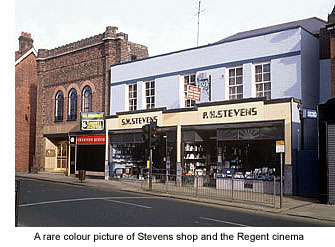 To hear a record by your favourite artist was one thing but to actually see a pop star at that time, especially in Bishop's Stortford, was something else. On consecutive Saturdays in April 1961, Wilf's shop played host to singers Ricky Valance and Lance Fortune – each booked for a one-hour autograph signing session. Ricky Valance had hit the Number One spot the previous year with Tell Laura I Love Her, but neither singer was destined to be a major star. The Beatles, however, were major stars and though they never came to Stevens shop to sign autographs, every record they released in the 1960s resulted in long queues of young people outside the shop wanting to buy a copy. To hear a record by your favourite artist was one thing but to actually see a pop star at that time, especially in Bishop's Stortford, was something else. On consecutive Saturdays in April 1961, Wilf's shop played host to singers Ricky Valance and Lance Fortune – each booked for a one-hour autograph signing session. Ricky Valance had hit the Number One spot the previous year with Tell Laura I Love Her, but neither singer was destined to be a major star. The Beatles, however, were major stars and though they never came to Stevens shop to sign autographs, every record they released in the 1960s resulted in long queues of young people outside the shop wanting to buy a copy.
After Marks & Spencer bought the site the Stevens brothers moved their business to Apton Road, but their occupancy there was brief. Percy died in February 1985, aged 80, and Wilf died a few months later, aged 69.
|
|
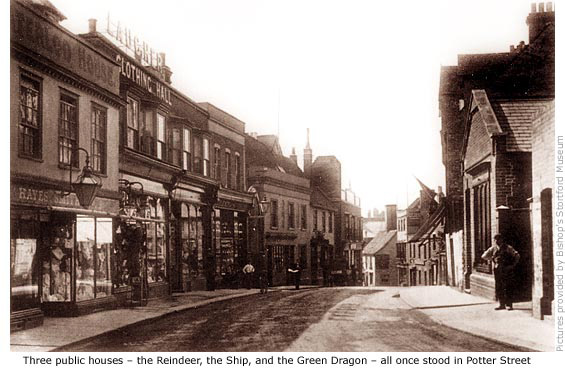
In the Middle Ages it was customary for every market place to have a Market Cross at its centre, and Bishop's Stortford's market was no exception. A far more ornate and important cross than any of those that stood at the entrance roads to the town, it was also called Potters Cross from which Potter Street takes its name. First mention of the cross's existence is in churchwardens' accounts of 1431. No material evidence of the cross has ever been found but in recent years part of a kiln chimney was unearthed here, possibly used by a Potter, which suggests why the cross was so named.
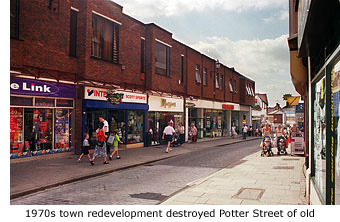 Potter Street was originally a continuation of Fish Row (or Fish Market) – now the narrow road behind the Corn Exchange – but it went by many different names including Potters Cross, Potters Hill, The Pultry Hill, Poultry Hill and, latterly, the Leather Market. All shops and houses that once lined the eastern side of the road were demolished in 1828 to make way for the Corn Exchange. Potter Street was originally a continuation of Fish Row (or Fish Market) – now the narrow road behind the Corn Exchange – but it went by many different names including Potters Cross, Potters Hill, The Pultry Hill, Poultry Hill and, latterly, the Leather Market. All shops and houses that once lined the eastern side of the road were demolished in 1828 to make way for the Corn Exchange.
Emphasising its connection with the market place and the original boundary of the medieval town, Potter Street spans only the short distance between Apton Road and Market Square. Buildings from that period disappeared long ago as did those from the 19th century with town redevelopment in the 1970s, their place taken by Woolworths store and Jackson Square. Woolworths had aready been present on this site, albeit in smaller premises, as had Burtons Tailors, who took over the old Reindeer public house in 1948. The western side of the road fared slightly better during this period, some older buildings between Church Street and Apton Road surviving into the 1980s before being replaced.
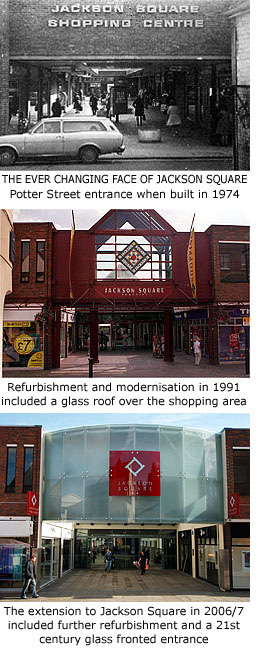 A classic example of 1960's achitecture is the partly pre-fabricated building owned by Boots at the corner of Church Street. Resident here since the 1920s, Boots previously occupied a much more substantial three-storey building on this site, erected around 1900. A classic example of 1960's achitecture is the partly pre-fabricated building owned by Boots at the corner of Church Street. Resident here since the 1920s, Boots previously occupied a much more substantial three-storey building on this site, erected around 1900.
That building replaced the Little King’s Head public house that stood from 1814 to 1899, its name likely to have been a humourous attempt to upstage the much larger King’s Head Inn that stood on the site of the present Corn Exchange (See Guide 2).
Boots store is adjoined by an early 20th century timber-frame building, itself adjoined to two small shops – Nos 4 and 6. The original house and shop on this site was owned by a fishmonger named Mr Muffett, but in the 1890s was purchased by the urban council and subsequently pulled down to make the road wider.
The distinct curve in the road at this point is due to another house that once stood at the top of Potter Street, its position creating a right-angled turn on the approach to Market Square from the south. Mail coaches found this extremely difficult to negotiate and didn't go through the town until it was demolished in the early 19th century.
In 1900, building work in another part of Potter Street revealed a tooth and a tusk of a Mammoth that had roamed this area over a quarter of a million years ago.
MORE PICTURES
|


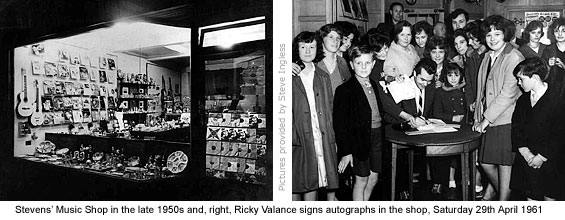


 To hear a record by your favourite artist was one thing but to actually see a pop star at that time, especially in Bishop's Stortford, was something else. On consecutive Saturdays in April 1961, Wilf's shop played host to singers Ricky Valance and Lance Fortune – each booked for a one-hour autograph signing session. Ricky Valance had hit the Number One spot the previous year with Tell Laura I Love Her, but neither singer was destined to be a major star. The Beatles, however, were major stars and though they never came to Stevens shop to sign autographs, every record they released in the 1960s resulted in long queues of young people outside the shop wanting to buy a copy.
To hear a record by your favourite artist was one thing but to actually see a pop star at that time, especially in Bishop's Stortford, was something else. On consecutive Saturdays in April 1961, Wilf's shop played host to singers Ricky Valance and Lance Fortune – each booked for a one-hour autograph signing session. Ricky Valance had hit the Number One spot the previous year with Tell Laura I Love Her, but neither singer was destined to be a major star. The Beatles, however, were major stars and though they never came to Stevens shop to sign autographs, every record they released in the 1960s resulted in long queues of young people outside the shop wanting to buy a copy.
 Potter Street was originally a continuation of Fish Row (or Fish Market) – now the narrow road behind the Corn Exchange – but it went by many different names including Potters Cross, Potters Hill, The Pultry Hill, Poultry Hill and, latterly, the Leather Market. All shops and houses that once lined the eastern side of the road were demolished in 1828 to make way for the Corn Exchange.
Potter Street was originally a continuation of Fish Row (or Fish Market) – now the narrow road behind the Corn Exchange – but it went by many different names including Potters Cross, Potters Hill, The Pultry Hill, Poultry Hill and, latterly, the Leather Market. All shops and houses that once lined the eastern side of the road were demolished in 1828 to make way for the Corn Exchange. A classic example of 1960's achitecture is the partly pre-fabricated building owned by Boots at the corner of Church Street. Resident here since the 1920s, Boots previously occupied a much more substantial three-storey building on this site, erected around 1900.
A classic example of 1960's achitecture is the partly pre-fabricated building owned by Boots at the corner of Church Street. Resident here since the 1920s, Boots previously occupied a much more substantial three-storey building on this site, erected around 1900.